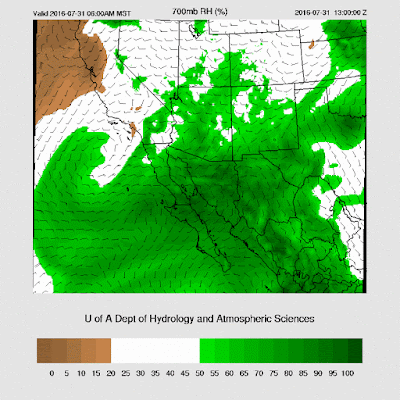The WRFGFS was way too wet while the WRFNAM and WRFRR dev were very good including the moderate storms that moved through Tucson around sunset. The WRFRR didn't have enough activity around Flagstaff.
 |
| WRFNAM |
A complex situation this morning with an ongoing MCS over far northern Mexico, forced by the large IT to the SW. Scattered to broken mid level clouds are slowly dissipating over southern Arizona so there is some question regarding the amount of heating we will receive. I was pleasantly surprised to see all three of the 12Z initializations having a fair amount of clouds present. Looking at the 2m temperature forecasts so far shows that the model runs are all a few degrees too warm, but not too bad. The WRFNAM was the most accurate.
The IT was initialized well by all as the Guaymas upper air data probably had something to do with that. No other significant circulations were noted. I noticed that the WRFRR is noticeably different with regards to the amount of RH at 700mb. Strange.
 |
| WRFRR |
 |
| WRFNAM |
Minimal IPW errors in all three. Overall, they are all good with no clear favorites except to say that the WRFNAM has been doing well recently thus that is my favorite. Model confidence is high.
Day 1
A very wet atmosphere is in place across much of the state with IPW of 45mm at Tucson and 51mm at Phoenix. By early afternoon, the surge continues to advect very wet air into the state. 850mb dewpoints are very high over much of the lower deserts, around 15C. I'm a little worried that this may be a 'too wet to rain' situation in Tucson where convection fires over the mountains early thus clouds and cooling outflows don't allow the lower elevations to heat enough for deep convection.
'Too wet to rain' is certainly a concern when steering is as light as is forecast by the WRFGFS this afternoon. The WRFRR and NAM have a bit high wind speeds; only 10 knots though. The 500mb high has been suppressed slightly due to a strong trough over the NW US. One center is in western NM and the other west of Vegas this afternoon.
CAPE again is forecast to be moderate to high, especially over the higher terrain. With good heating, expect rapid development of storms in those locations. Very heavy rain and wet microbursts are likely.
Deep convection forms in far southern Arizona and over the Rim/White Mountains. The far southern Arizona activity moves slowly towards the Tucson area during the afternoon. All the model runs are similar except the WRFGFS has quite a bit more activity near the border.
The Tucson afternoon forecast skew-t has high CAPE and a very good wind profile. Mid-level speeds could be a bit higher, but the lower level inflow is around 15 knots while the upper-level flow is out of the SW thus blowing anvils away to the NE and not interfering with heating and vertical velocities. It's been shown (CuPIDO 2006) that weak downward vertical velocities are present under anvils. There was a nice example of that over Mt Lemmon recently. The only issue is the fairly strong inversion at the top of the PBL thus a good outflow will be needed to lift to the LFC which is around 700mb. Strong outflows are not forecast as the cloud bases are so low and IPW is so high.
The only model run to forecast even a moderate outflow into Tucson is the WRFGFS, which has been too aggressive with convection all summer so far.
The WRFGFS does develop some storms in the Tucson area, but they are only scattered. The WRFNAM and WRFRR have only limited activity in the lower elevations with most remaining on the higher terrain.
 |
| WRFGFS |
 |
| WRFNAM |
The situation is a bit better (or a lot depending on the model run!) as the atmosphere is mixed nearly to the LFC during the late afternoon with moderate CAPE, and a good wind profile. A few weak outflows are all that is needed to get deep convection started. As the PBL is mixed higher in and around Phoenix, outflows are likely to be strong. Also, with such a wet airmass, wet microbursts are likely with stronger storms. Very heavy rain too.
The WRFGFS and WRFRR both bring in moderate outflows from the south and northeast into the Phoenix area for a classic outflow intersection situation. The WRFNAM as it has less activity in SE Arizona only has a moderate outflow from the NE.
 |
| WRFNAM |
The WRFNAM is able to develop scattered deep convection with the single outflow.
On the other hand, if outflow intersections occur, like in the WRFRR and WRFGFS, stronger storms form over Maricopa and Pinal counties this evening. The WRFGFS really goes nuts over Phoenix, but I believe it is overdoing things.
 |
| WRFRR |
This just in from the 15Z WRFRR dev. Not much activity around Tucson, but a strong/severe line of storms skirts the northern parts of Maricopa county. I haven't had a chance to look at this run in detail so it's unknown how accurate it is.
I am going to skip Day 2 again due to the typical uncertainty with an active and complex Day 1.










No comments:
Post a Comment
Note: Only a member of this blog may post a comment.